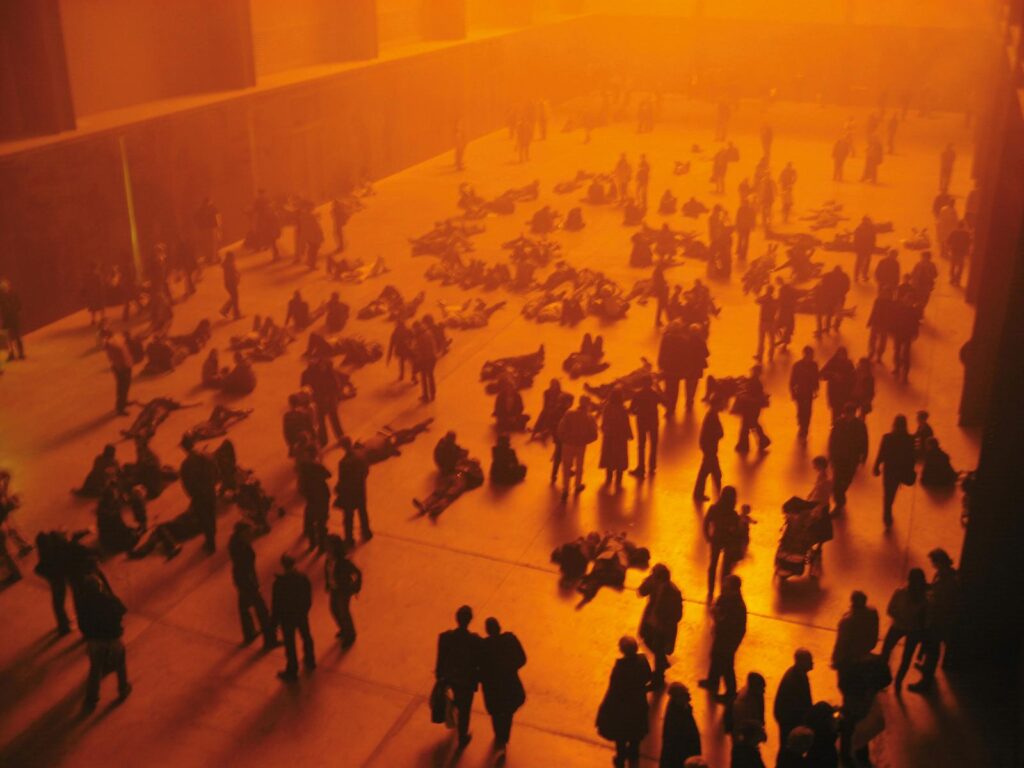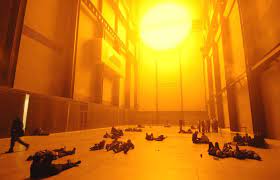Topic: Solar energy and electric circuit
Area: Engineering
Abstract: Inspired from Olafur Eliasson’s “The Weather Project”, the participants will be part of an electric circuit powered up by solar energy. Each one will take responsibility for specific actions related to the circuit elements they are personifying (solar panel, battery, switch, light source
Learning objectives:
•How an electric circuit works
•The concept and characteristics of solar energy
•Ethic of sustainability
•Team building skills
•Critical thinking
•Problem solving
•Principles of electromagnetism
Advisable age of students: 10-14
Previous knowledge: None
Global development
Total duration: 60-90 min
Materials: Free room space to perform the activity; A whiteboard/board for reflection and debate; Plastic/tennis/paper playballs; basket case; cardboard; markers.
Phase 1 Visualisation
Duration: 20 min
Development: Olafur Eliasson’s representations of the sun and sky dominate the expanse of the Turbine Hall at Tate Modern in London. A fine mist permeates the space, as if creeping in from the environment outside. Throughout the day, the mist accumulates into faint, cloud-like formations, before dissipating across the space. The inspiration of sun energy and weather changes brings students to reflect on the importance of environment, the actual system fragilities, and the possibilities of shifting from carbon to clean energy. The trainer will explain (ex. through a draw on the whiteboard) the main elements of the circuit, and how to shape it within the given space. Each participant will have a role to play. Prior the beginning of the activity, the participants will draw a solar panel – and the other devices that are included in your circuit – on a cardboard (just representative, nothing technical), and dispose the basket cases along the circuit: one for each appliance/energy consuming source, one for the battery, and one for the solar panel (which will be the energy source).
Phase 2 Artistic action and experimentation
Duration: 30/40 min
Development: Build a parallel circuit with:
•Solar panel (the main energy source – 10/s balls)
•Light bulb (energy consumer – 1/s ball)
•Appliances/devices (energy consumer- could be phone charging or a tv – 1-2/s balls)
• Battery (energy saver – 1/s ball)
• Basket cases for each element to allocate the playballs
Each element has an energy consumption/saving capacity. When the light in the room is on, the student playing the solar panel distributes the playballs one-by-one, and the circuit has to decide where to allocate the energy (ex. light the bulb, charging a phone, watching tv). When the light is off, the battery (that saved an amount of energy/playballs) starts distributing the playballs collected in the basket case to power up the circuit. Meantime, all the energy consumer elements are losing energy while in use. Therefore, the students have to decide where to allocate the saved energy from the battery to power up one or more devices (or none). Here’s the catch; the trainer will leave off the light more than was on, testing the problem-solving ability of the group, and their critical thinking skill to decide what’s best to perform efficiently.
Phase 3: Reflexion and debate
Duration: 10/15 min
Development: Focus group and brainstorming could be used to interact and receive feedback
Engagement – How it was for you to collaborate with your peers? Did you feel active part of the circuit? How do you think the decisions made influenced the result of the activity?
Emotions – Which kind of emotions have you experienced during the different moments of the performance? Did you face any challenge during the development of the exercise?How did you overcome it?
Efficacy – Do you think the activity was well-explained? How did you find the support of the trainer? Did you learn something about the topic? What would you suggest to improve the trainer approach? And what about the activity? Do you think the material was correctly set for the development of the exercise? Is there any other suggestion or reflection that would you like to share?
References and links: Olafur Eliasson, The Weather Project, 2003 – Installation in Turbine Hall, Tate Modern, London
https://www.tate.org.uk/whats-on/tate-modern/exhibition/unilever-series/unilever-series-olafur-eliasson-weather-project-0


